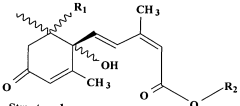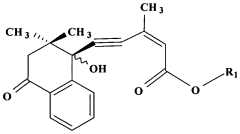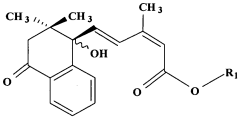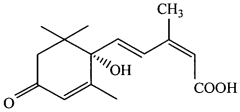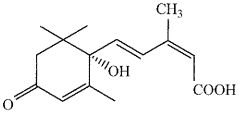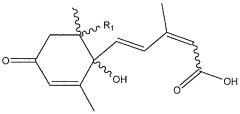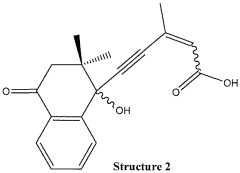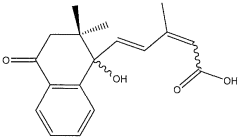How Abscisic Acid Influences Photosynthesis Efficiency?
JUL 14, 20259 MIN READ
Generate Your Research Report Instantly with AI Agent
Patsnap Eureka helps you evaluate technical feasibility & market potential.
ABA and Photosynthesis Background
Abscisic acid (ABA) and photosynthesis are two fundamental aspects of plant biology that play crucial roles in plant growth, development, and stress responses. ABA, a plant hormone discovered in the 1960s, is primarily known for its involvement in various physiological processes, including seed dormancy, stomatal closure, and stress tolerance. Photosynthesis, on the other hand, is the process by which plants convert light energy into chemical energy, forming the basis of life on Earth.
The relationship between ABA and photosynthesis has been a subject of intense research in recent decades. Initially, ABA was primarily associated with plant responses to abiotic stresses, particularly drought stress. However, as our understanding of plant physiology has advanced, it has become increasingly clear that ABA plays a complex and multifaceted role in regulating photosynthetic efficiency.
ABA's influence on photosynthesis is primarily mediated through its effects on stomatal aperture. Stomata are microscopic pores on the leaf surface that regulate gas exchange between the plant and the atmosphere. Under stress conditions, such as drought or high temperatures, ABA triggers stomatal closure, which helps conserve water but also reduces CO2 uptake, potentially limiting photosynthetic rates.
However, the interplay between ABA and photosynthesis extends beyond stomatal regulation. Research has shown that ABA can directly affect the expression of genes involved in photosynthetic processes, including those encoding chlorophyll biosynthesis enzymes and components of the photosynthetic apparatus. This suggests a more intricate regulatory role for ABA in fine-tuning photosynthetic efficiency.
Furthermore, ABA has been implicated in the modulation of non-photochemical quenching (NPQ), a protective mechanism that dissipates excess light energy as heat. This process is crucial for preventing photodamage under high light conditions, indicating that ABA may play a role in optimizing photosynthetic performance across varying light environments.
The study of ABA's influence on photosynthesis efficiency has significant implications for agriculture and plant biotechnology. As global climate change leads to more frequent and severe environmental stresses, understanding how ABA mediates the balance between stress tolerance and photosynthetic productivity becomes increasingly important. This knowledge could potentially be leveraged to develop crops with improved water-use efficiency and stress tolerance without compromising yield.
Recent advances in molecular biology and genetics have provided new tools for investigating the complex interactions between ABA signaling and photosynthetic processes. Techniques such as high-throughput sequencing, metabolomics, and advanced imaging technologies are enabling researchers to dissect the molecular mechanisms underlying ABA's effects on photosynthesis with unprecedented detail.
The relationship between ABA and photosynthesis has been a subject of intense research in recent decades. Initially, ABA was primarily associated with plant responses to abiotic stresses, particularly drought stress. However, as our understanding of plant physiology has advanced, it has become increasingly clear that ABA plays a complex and multifaceted role in regulating photosynthetic efficiency.
ABA's influence on photosynthesis is primarily mediated through its effects on stomatal aperture. Stomata are microscopic pores on the leaf surface that regulate gas exchange between the plant and the atmosphere. Under stress conditions, such as drought or high temperatures, ABA triggers stomatal closure, which helps conserve water but also reduces CO2 uptake, potentially limiting photosynthetic rates.
However, the interplay between ABA and photosynthesis extends beyond stomatal regulation. Research has shown that ABA can directly affect the expression of genes involved in photosynthetic processes, including those encoding chlorophyll biosynthesis enzymes and components of the photosynthetic apparatus. This suggests a more intricate regulatory role for ABA in fine-tuning photosynthetic efficiency.
Furthermore, ABA has been implicated in the modulation of non-photochemical quenching (NPQ), a protective mechanism that dissipates excess light energy as heat. This process is crucial for preventing photodamage under high light conditions, indicating that ABA may play a role in optimizing photosynthetic performance across varying light environments.
The study of ABA's influence on photosynthesis efficiency has significant implications for agriculture and plant biotechnology. As global climate change leads to more frequent and severe environmental stresses, understanding how ABA mediates the balance between stress tolerance and photosynthetic productivity becomes increasingly important. This knowledge could potentially be leveraged to develop crops with improved water-use efficiency and stress tolerance without compromising yield.
Recent advances in molecular biology and genetics have provided new tools for investigating the complex interactions between ABA signaling and photosynthetic processes. Techniques such as high-throughput sequencing, metabolomics, and advanced imaging technologies are enabling researchers to dissect the molecular mechanisms underlying ABA's effects on photosynthesis with unprecedented detail.
Market for ABA-based Agricultural Solutions
The market for ABA-based agricultural solutions has been experiencing significant growth in recent years, driven by the increasing demand for sustainable and efficient crop management practices. As farmers and agricultural businesses seek ways to enhance crop resilience and productivity in the face of climate change and water scarcity, ABA-based products have emerged as a promising solution.
The global market for plant growth regulators, which includes ABA-based products, was valued at approximately $2.5 billion in 2020 and is projected to reach $3.8 billion by 2025, growing at a CAGR of 8.7%. Within this market, ABA-based solutions are gaining traction due to their ability to improve plant stress tolerance and water use efficiency.
Key market segments for ABA-based agricultural solutions include drought-resistant crops, high-value horticultural products, and precision agriculture applications. The fruit and vegetable sector, in particular, has shown strong adoption of ABA-based products to improve crop quality and yield under water-limited conditions.
Geographically, North America and Europe currently lead the market for ABA-based solutions, owing to their advanced agricultural practices and regulatory support for innovative crop management technologies. However, emerging markets in Asia-Pacific and Latin America are expected to witness rapid growth in the coming years, driven by increasing awareness of sustainable farming practices and the need to adapt to changing climate conditions.
The market landscape is characterized by a mix of established agrochemical companies and innovative startups. Major players such as Syngenta, BASF, and Bayer have invested in ABA-related research and product development, while specialized firms like Valent BioSciences have introduced targeted ABA formulations for specific crop applications.
Challenges in the ABA market include the need for further research to optimize application methods and timing, as well as the development of cost-effective production processes to make ABA-based solutions more accessible to a broader range of farmers. Additionally, regulatory hurdles in some regions may slow market penetration, necessitating continued efforts to demonstrate the safety and efficacy of ABA-based products.
Despite these challenges, the market outlook for ABA-based agricultural solutions remains positive. The growing emphasis on sustainable agriculture, coupled with the increasing frequency of extreme weather events, is expected to drive continued innovation and adoption of ABA technologies. As research advances our understanding of ABA's role in photosynthesis efficiency and stress response, new market opportunities are likely to emerge, potentially expanding the application of ABA-based solutions beyond traditional crop protection to areas such as post-harvest management and seed treatment.
The global market for plant growth regulators, which includes ABA-based products, was valued at approximately $2.5 billion in 2020 and is projected to reach $3.8 billion by 2025, growing at a CAGR of 8.7%. Within this market, ABA-based solutions are gaining traction due to their ability to improve plant stress tolerance and water use efficiency.
Key market segments for ABA-based agricultural solutions include drought-resistant crops, high-value horticultural products, and precision agriculture applications. The fruit and vegetable sector, in particular, has shown strong adoption of ABA-based products to improve crop quality and yield under water-limited conditions.
Geographically, North America and Europe currently lead the market for ABA-based solutions, owing to their advanced agricultural practices and regulatory support for innovative crop management technologies. However, emerging markets in Asia-Pacific and Latin America are expected to witness rapid growth in the coming years, driven by increasing awareness of sustainable farming practices and the need to adapt to changing climate conditions.
The market landscape is characterized by a mix of established agrochemical companies and innovative startups. Major players such as Syngenta, BASF, and Bayer have invested in ABA-related research and product development, while specialized firms like Valent BioSciences have introduced targeted ABA formulations for specific crop applications.
Challenges in the ABA market include the need for further research to optimize application methods and timing, as well as the development of cost-effective production processes to make ABA-based solutions more accessible to a broader range of farmers. Additionally, regulatory hurdles in some regions may slow market penetration, necessitating continued efforts to demonstrate the safety and efficacy of ABA-based products.
Despite these challenges, the market outlook for ABA-based agricultural solutions remains positive. The growing emphasis on sustainable agriculture, coupled with the increasing frequency of extreme weather events, is expected to drive continued innovation and adoption of ABA technologies. As research advances our understanding of ABA's role in photosynthesis efficiency and stress response, new market opportunities are likely to emerge, potentially expanding the application of ABA-based solutions beyond traditional crop protection to areas such as post-harvest management and seed treatment.
Current Understanding of ABA-Photosynthesis Interaction
The interaction between abscisic acid (ABA) and photosynthesis efficiency is a complex and multifaceted relationship that has been the subject of extensive research in plant physiology. ABA, a plant hormone primarily known for its role in stress responses, has been found to significantly influence photosynthetic processes in various ways.
One of the primary mechanisms through which ABA affects photosynthesis is by regulating stomatal aperture. Under water stress conditions, ABA levels in plants increase, triggering stomatal closure. This response helps conserve water but simultaneously reduces CO2 uptake, potentially limiting photosynthetic rates. However, the relationship is not straightforward, as moderate increases in ABA can actually enhance water use efficiency without significantly impacting carbon assimilation.
ABA has also been shown to influence the expression of genes related to photosynthesis. Studies have revealed that ABA can downregulate the expression of certain photosynthesis-related genes, particularly those encoding chlorophyll biosynthesis enzymes and light-harvesting complex proteins. This modulation can lead to a reduction in photosynthetic capacity, especially under prolonged stress conditions.
Interestingly, ABA's impact on photosynthesis varies depending on the duration and intensity of stress. Short-term ABA signaling can actually enhance photosynthetic efficiency by improving water use efficiency and promoting protective mechanisms against oxidative stress. However, long-term or severe stress conditions often result in a decline in photosynthetic performance due to sustained ABA-mediated responses.
Recent research has uncovered more nuanced effects of ABA on photosynthesis. For instance, ABA has been found to influence the activity of key enzymes involved in carbon fixation, such as Rubisco. Some studies suggest that ABA can enhance Rubisco activity under certain conditions, potentially as a compensatory mechanism for reduced CO2 availability due to stomatal closure.
Furthermore, ABA plays a crucial role in photoprotection mechanisms. It has been observed to upregulate genes involved in non-photochemical quenching (NPQ), a process that dissipates excess light energy as heat, protecting the photosynthetic apparatus from damage. This protective function is particularly important under high light stress conditions, where it helps maintain photosynthetic efficiency by preventing photoinhibition.
The current understanding also highlights the importance of ABA in regulating source-sink relationships within plants. By influencing carbohydrate partitioning and phloem loading, ABA indirectly affects photosynthetic rates through feedback inhibition mechanisms. This aspect of ABA-photosynthesis interaction is particularly relevant in understanding whole-plant responses to environmental stresses.
One of the primary mechanisms through which ABA affects photosynthesis is by regulating stomatal aperture. Under water stress conditions, ABA levels in plants increase, triggering stomatal closure. This response helps conserve water but simultaneously reduces CO2 uptake, potentially limiting photosynthetic rates. However, the relationship is not straightforward, as moderate increases in ABA can actually enhance water use efficiency without significantly impacting carbon assimilation.
ABA has also been shown to influence the expression of genes related to photosynthesis. Studies have revealed that ABA can downregulate the expression of certain photosynthesis-related genes, particularly those encoding chlorophyll biosynthesis enzymes and light-harvesting complex proteins. This modulation can lead to a reduction in photosynthetic capacity, especially under prolonged stress conditions.
Interestingly, ABA's impact on photosynthesis varies depending on the duration and intensity of stress. Short-term ABA signaling can actually enhance photosynthetic efficiency by improving water use efficiency and promoting protective mechanisms against oxidative stress. However, long-term or severe stress conditions often result in a decline in photosynthetic performance due to sustained ABA-mediated responses.
Recent research has uncovered more nuanced effects of ABA on photosynthesis. For instance, ABA has been found to influence the activity of key enzymes involved in carbon fixation, such as Rubisco. Some studies suggest that ABA can enhance Rubisco activity under certain conditions, potentially as a compensatory mechanism for reduced CO2 availability due to stomatal closure.
Furthermore, ABA plays a crucial role in photoprotection mechanisms. It has been observed to upregulate genes involved in non-photochemical quenching (NPQ), a process that dissipates excess light energy as heat, protecting the photosynthetic apparatus from damage. This protective function is particularly important under high light stress conditions, where it helps maintain photosynthetic efficiency by preventing photoinhibition.
The current understanding also highlights the importance of ABA in regulating source-sink relationships within plants. By influencing carbohydrate partitioning and phloem loading, ABA indirectly affects photosynthetic rates through feedback inhibition mechanisms. This aspect of ABA-photosynthesis interaction is particularly relevant in understanding whole-plant responses to environmental stresses.
Existing Methods to Study ABA Effects
01 Abscisic acid's role in photosynthesis regulation
Abscisic acid (ABA) plays a crucial role in regulating photosynthesis efficiency. It influences stomatal closure, which affects CO2 uptake and water loss, thereby impacting photosynthetic rates. ABA also modulates the expression of genes related to photosynthetic processes, helping plants adapt to various environmental stresses.- Abscisic acid's role in photosynthesis regulation: Abscisic acid (ABA) plays a crucial role in regulating photosynthesis efficiency. It influences stomatal closure, which affects CO2 uptake and water loss, thereby impacting photosynthetic rates. ABA also modulates the expression of genes related to photosynthetic processes, helping plants adapt to various environmental stresses.
- ABA-mediated stress response and photosynthetic efficiency: ABA is a key hormone in plant stress responses, particularly drought stress. It enhances plant tolerance to abiotic stresses, which indirectly affects photosynthetic efficiency. By regulating stress-responsive genes and physiological processes, ABA helps maintain photosynthetic capacity under adverse conditions.
- ABA analogs and synthetic compounds for improving photosynthesis: Synthetic ABA analogs and related compounds can be used to enhance photosynthetic efficiency. These compounds mimic or modulate ABA's effects on plants, potentially improving their ability to maintain photosynthesis under stress conditions or optimizing carbon fixation rates.
- Interaction of ABA with other plant hormones in photosynthesis regulation: ABA interacts with other plant hormones such as cytokinins, auxins, and ethylene to regulate photosynthesis. These interactions influence various aspects of photosynthetic processes, including chlorophyll synthesis, leaf senescence, and carbon allocation, ultimately affecting overall photosynthetic efficiency.
- Genetic manipulation of ABA pathways for improved photosynthesis: Genetic engineering techniques targeting ABA biosynthesis, signaling, or response pathways can be used to enhance photosynthetic efficiency. By modifying genes involved in ABA metabolism or perception, researchers aim to develop plants with improved photosynthetic performance, especially under stress conditions.
02 ABA-mediated stress response and photosynthetic efficiency
ABA is a key hormone in plant stress responses, particularly drought stress. It enhances plant tolerance to abiotic stresses, which can indirectly improve photosynthetic efficiency under adverse conditions. ABA-induced changes in leaf morphology and chloroplast structure can also contribute to maintaining photosynthetic capacity during stress.Expand Specific Solutions03 ABA signaling pathways and photosynthetic apparatus
ABA signaling pathways interact with the photosynthetic apparatus, influencing its efficiency. These pathways can affect the activity of photosynthetic enzymes, the stability of photosystems, and the regulation of carbon fixation. Understanding these interactions can lead to strategies for enhancing photosynthetic efficiency through ABA-related mechanisms.Expand Specific Solutions04 Genetic manipulation of ABA biosynthesis for improved photosynthesis
Genetic engineering approaches targeting ABA biosynthesis and signaling pathways can be used to enhance photosynthetic efficiency. This includes modifying genes involved in ABA production, perception, or downstream signaling to optimize plant responses and improve carbon assimilation under various environmental conditions.Expand Specific Solutions05 ABA's influence on chlorophyll content and photosynthetic pigments
ABA affects the synthesis and degradation of chlorophyll and other photosynthetic pigments. By modulating pigment levels, ABA can influence light harvesting efficiency and overall photosynthetic performance. Understanding this relationship can lead to strategies for optimizing pigment composition to enhance photosynthetic efficiency.Expand Specific Solutions
Key Players in ABA and Plant Science Research
The research on abscisic acid's influence on photosynthesis efficiency is in a developing stage, with growing market potential as agricultural sustainability gains importance. The technology is moderately mature, with ongoing research to fully understand its mechanisms and applications. Key players include academic institutions like Zhejiang University, China Agricultural University, and Nanjing Normal University, alongside companies such as Valent BioSciences Corp. and Sumitomo Chemical Co., Ltd. These organizations are advancing the field through collaborative research efforts and product development, aiming to enhance crop productivity and stress tolerance in agriculture.
Zhejiang University
Technical Solution: Zhejiang University has developed a novel approach to enhance photosynthesis efficiency through abscisic acid (ABA) regulation. Their research focuses on the molecular mechanisms of ABA-mediated stomatal closure and its impact on CO2 uptake. They have identified key signaling components, such as SLAC1 anion channels and OST1 protein kinase, which are crucial for ABA-induced stomatal closure[1]. The team has also engineered plants with modified ABA receptors to fine-tune stomatal responses, potentially improving water use efficiency without significantly compromising photosynthetic rate[3]. Additionally, they are exploring the role of ABA in chloroplast retrograde signaling, which influences nuclear gene expression related to photosynthesis[5].
Strengths: Comprehensive understanding of ABA signaling pathways; Innovative genetic engineering approaches. Weaknesses: Potential trade-offs between water conservation and carbon fixation; Complexity in translating laboratory findings to field conditions.
China Agricultural University
Technical Solution: China Agricultural University has made significant strides in understanding how ABA influences photosynthesis efficiency, particularly in crop plants under stress conditions. Their research has revealed that ABA-induced stomatal closure, while conserving water, can lead to decreased CO2 uptake and potentially reduced photosynthetic efficiency[2]. To address this, they have developed strategies to optimize ABA-mediated responses, including the use of nanoparticles for controlled ABA delivery to specific plant tissues[4]. The university's team has also investigated the crosstalk between ABA and other phytohormones, such as cytokinins and auxins, in regulating photosynthetic processes under various environmental stresses[6]. Their work extends to improving crop resilience to drought and heat stress through ABA-responsive gene manipulation.
Strengths: Practical applications in crop improvement; Advanced techniques in hormone delivery and gene manipulation. Weaknesses: Potential unintended consequences of altering hormone balances; Challenges in scaling up to diverse crop varieties and field conditions.
Breakthrough Studies on ABA-Photosynthesis Link
Liquid compositions containing s-(+)-abscisic acid in combination with selected lipophilic agents and methods of their preparation
PatentWO2008094588A1
Innovation
- The development of liquid compositions containing S-(+)-abscisic acid in combination with selected lipophilic surface active agents, such as ethoxylated amines, which enhance solubility and stability, allowing for higher concentration formulations that can be diluted without precipitation, and include antimicrobial agents for stability.
Salts, aqueous liquid compositions salts of abscisic acid analogs and methods of their preparation
PatentWO2010011802A1
Innovation
- The use of salts of abscisic acid analogs prepared with alkali metal cations of high molecular weight or large steric bulk, such as rubidium, cesium, or organic quaternary ammonium salts, significantly increases solubility in water, allowing for concentrated solutions up to 50% by weight without precipitation risks, and enhances biological activity.
Environmental Factors Influencing ABA Action
Abscisic acid (ABA) plays a crucial role in plant responses to environmental stresses, and its influence on photosynthesis efficiency is significantly modulated by various environmental factors. Understanding these factors is essential for comprehending the complex interplay between ABA signaling and photosynthetic processes.
Water availability is a primary environmental factor affecting ABA action on photosynthesis. During drought conditions, ABA levels in plants increase, triggering stomatal closure to conserve water. This response, while beneficial for water retention, can limit CO2 uptake and consequently reduce photosynthetic efficiency. The severity and duration of water stress directly impact the extent of ABA-induced stomatal closure and its effects on photosynthesis.
Temperature is another critical factor influencing ABA's role in photosynthesis regulation. High temperatures can enhance ABA biosynthesis and signaling, leading to increased stomatal closure and reduced transpiration. This protective mechanism helps prevent excessive water loss but may also decrease photosynthetic rates. Conversely, low temperatures can alter ABA sensitivity in guard cells, potentially affecting the plant's ability to regulate stomatal aperture and maintain optimal photosynthetic efficiency.
Light intensity and quality significantly impact ABA-mediated responses in photosynthesis. High light conditions can increase ABA production, particularly when combined with other stressors like drought. This elevated ABA level can lead to stomatal closure and photoprotective mechanisms, which may temporarily reduce photosynthetic efficiency but protect the photosynthetic apparatus from damage. The spectral composition of light also influences ABA signaling, with blue light known to enhance ABA-induced stomatal closure.
Atmospheric CO2 concentration is an environmental factor that interacts with ABA signaling to affect photosynthesis. Elevated CO2 levels can partially counteract the ABA-induced reduction in photosynthetic efficiency by increasing the CO2 gradient across stomata, even when they are partially closed. This interaction highlights the complex relationship between environmental factors and ABA's influence on photosynthesis.
Soil nutrient availability also modulates ABA's impact on photosynthesis. Nutrient deficiencies, particularly nitrogen and phosphorus, can alter ABA biosynthesis and signaling pathways. These changes can affect stomatal behavior and photosynthetic capacity, influencing how ABA regulates photosynthetic efficiency under varying nutrient conditions.
Lastly, air humidity plays a role in ABA-mediated photosynthetic responses. Low humidity increases transpiration rates, potentially triggering ABA production and stomatal closure. This response can affect CO2 uptake and photosynthetic efficiency, demonstrating how atmospheric moisture levels interact with ABA signaling to influence photosynthesis.
Understanding these environmental factors and their interactions with ABA signaling is crucial for predicting and managing plant responses to stress, particularly in the context of climate change and agricultural productivity. Future research in this area will likely focus on developing strategies to optimize ABA-mediated responses for enhanced photosynthetic efficiency under varying environmental conditions.
Water availability is a primary environmental factor affecting ABA action on photosynthesis. During drought conditions, ABA levels in plants increase, triggering stomatal closure to conserve water. This response, while beneficial for water retention, can limit CO2 uptake and consequently reduce photosynthetic efficiency. The severity and duration of water stress directly impact the extent of ABA-induced stomatal closure and its effects on photosynthesis.
Temperature is another critical factor influencing ABA's role in photosynthesis regulation. High temperatures can enhance ABA biosynthesis and signaling, leading to increased stomatal closure and reduced transpiration. This protective mechanism helps prevent excessive water loss but may also decrease photosynthetic rates. Conversely, low temperatures can alter ABA sensitivity in guard cells, potentially affecting the plant's ability to regulate stomatal aperture and maintain optimal photosynthetic efficiency.
Light intensity and quality significantly impact ABA-mediated responses in photosynthesis. High light conditions can increase ABA production, particularly when combined with other stressors like drought. This elevated ABA level can lead to stomatal closure and photoprotective mechanisms, which may temporarily reduce photosynthetic efficiency but protect the photosynthetic apparatus from damage. The spectral composition of light also influences ABA signaling, with blue light known to enhance ABA-induced stomatal closure.
Atmospheric CO2 concentration is an environmental factor that interacts with ABA signaling to affect photosynthesis. Elevated CO2 levels can partially counteract the ABA-induced reduction in photosynthetic efficiency by increasing the CO2 gradient across stomata, even when they are partially closed. This interaction highlights the complex relationship between environmental factors and ABA's influence on photosynthesis.
Soil nutrient availability also modulates ABA's impact on photosynthesis. Nutrient deficiencies, particularly nitrogen and phosphorus, can alter ABA biosynthesis and signaling pathways. These changes can affect stomatal behavior and photosynthetic capacity, influencing how ABA regulates photosynthetic efficiency under varying nutrient conditions.
Lastly, air humidity plays a role in ABA-mediated photosynthetic responses. Low humidity increases transpiration rates, potentially triggering ABA production and stomatal closure. This response can affect CO2 uptake and photosynthetic efficiency, demonstrating how atmospheric moisture levels interact with ABA signaling to influence photosynthesis.
Understanding these environmental factors and their interactions with ABA signaling is crucial for predicting and managing plant responses to stress, particularly in the context of climate change and agricultural productivity. Future research in this area will likely focus on developing strategies to optimize ABA-mediated responses for enhanced photosynthetic efficiency under varying environmental conditions.
Potential Applications in Crop Improvement
The potential applications of understanding how abscisic acid (ABA) influences photosynthesis efficiency in crop improvement are vast and promising. By leveraging this knowledge, researchers and agricultural scientists can develop innovative strategies to enhance crop productivity, stress tolerance, and overall yield.
One of the primary applications lies in breeding programs aimed at developing drought-resistant crops. As ABA plays a crucial role in regulating stomatal closure during water stress, crops with optimized ABA signaling pathways could maintain higher photosynthetic efficiency under drought conditions. This could lead to the development of varieties that require less irrigation, making agriculture more sustainable in water-scarce regions.
Furthermore, understanding the ABA-photosynthesis relationship can aid in creating crops with improved heat tolerance. High temperatures often lead to increased ABA production, which can negatively impact photosynthesis. By fine-tuning ABA responses, it may be possible to develop crops that maintain optimal photosynthetic rates even under elevated temperatures, thus expanding the geographical range of cultivation for many important food crops.
Another potential application is in the development of crops with enhanced carbon fixation capabilities. By modulating ABA-mediated responses, it may be possible to optimize the balance between CO2 uptake and water loss, leading to improved water use efficiency without compromising photosynthetic rates. This could result in crops that produce higher yields with the same or reduced water input.
The knowledge of ABA's influence on photosynthesis can also be applied to improve crop resilience to other abiotic stresses, such as salinity and cold. By engineering plants with modified ABA sensitivity or altered ABA biosynthesis pathways, it may be possible to develop crops that maintain higher photosynthetic efficiency under these adverse conditions.
Moreover, this understanding can be leveraged in the development of precision agriculture techniques. By monitoring ABA levels or related physiological markers, farmers could make more informed decisions about irrigation timing and quantity, optimizing water use while maintaining high photosynthetic efficiency and crop productivity.
Lastly, the insights gained from studying ABA's role in photosynthesis could be applied to the development of novel agrochemicals. These could include compounds that mimic or modulate ABA's effects on photosynthesis, providing farmers with tools to fine-tune crop responses to environmental conditions and maximize yield potential.
One of the primary applications lies in breeding programs aimed at developing drought-resistant crops. As ABA plays a crucial role in regulating stomatal closure during water stress, crops with optimized ABA signaling pathways could maintain higher photosynthetic efficiency under drought conditions. This could lead to the development of varieties that require less irrigation, making agriculture more sustainable in water-scarce regions.
Furthermore, understanding the ABA-photosynthesis relationship can aid in creating crops with improved heat tolerance. High temperatures often lead to increased ABA production, which can negatively impact photosynthesis. By fine-tuning ABA responses, it may be possible to develop crops that maintain optimal photosynthetic rates even under elevated temperatures, thus expanding the geographical range of cultivation for many important food crops.
Another potential application is in the development of crops with enhanced carbon fixation capabilities. By modulating ABA-mediated responses, it may be possible to optimize the balance between CO2 uptake and water loss, leading to improved water use efficiency without compromising photosynthetic rates. This could result in crops that produce higher yields with the same or reduced water input.
The knowledge of ABA's influence on photosynthesis can also be applied to improve crop resilience to other abiotic stresses, such as salinity and cold. By engineering plants with modified ABA sensitivity or altered ABA biosynthesis pathways, it may be possible to develop crops that maintain higher photosynthetic efficiency under these adverse conditions.
Moreover, this understanding can be leveraged in the development of precision agriculture techniques. By monitoring ABA levels or related physiological markers, farmers could make more informed decisions about irrigation timing and quantity, optimizing water use while maintaining high photosynthetic efficiency and crop productivity.
Lastly, the insights gained from studying ABA's role in photosynthesis could be applied to the development of novel agrochemicals. These could include compounds that mimic or modulate ABA's effects on photosynthesis, providing farmers with tools to fine-tune crop responses to environmental conditions and maximize yield potential.
Unlock deeper insights with Patsnap Eureka Quick Research — get a full tech report to explore trends and direct your research. Try now!
Generate Your Research Report Instantly with AI Agent
Supercharge your innovation with Patsnap Eureka AI Agent Platform!
